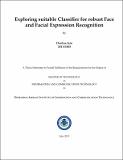Please use this identifier to cite or link to this item:
http://drsr.daiict.ac.in//handle/123456789/419| Title: | Exploring suitable classifier for robust face and facial expression recognition. |
| Authors: | Mitra, Suman K. Jain, Deshna |
| Keywords: | Face recognition Face perception Data processing Facial Expression Recognition Robust Face Recognition |
| Issue Date: | 2013 |
| Publisher: | Dhirubhai Ambani Institute of Information and Communication Technology |
| Citation: | Jain, Deshna (2013). Exploring suitable classifier for robust face and facial expression recognition.. Dhirubhai Ambani Institute of Information and Communication Technology, xi, 44 p. (Acc.No: T00382) |
| Abstract: | Face recognition by machines has been studied since last few decades and the problem is attempted to be solved by various ways. However any robust solution is not acheived yet by the researchers due to numerous challenges involved like illumination changes, pose variation, occlusion, cluttered background, noncooperation of the subject and ageing effect on human face. We have worked by modelling the problem as a pattern recogniton problem. The solution of this problem involves mainly three steps: (a) Face detection and segmentation, (b) Feature extraction, and (c) Classification or recognition. We have worked on finding the robust classifier for face and facial expression recognition. Naive Bayes Classifier (NBC) is the statistical classifier that works by estimating the maximum probability of the possible classes to which the testing data point may belong assuming that the features are mutually independent. It makes use of Bayes rule for likelihood computation. This approach works well if the distribution of the features is known accurately. Otherwise, probability distribution of the features belonging to corresponding classes has to be estimated with density estimation techniques. Here features are assumed to follow Gaussian distribution. Experiments are done for classifying faces from YALE face database and DAIICT database, taking ELPP coefficients as the features. Another classifier we used is Support Vector Machine (SVM) that works by finding the decision plane between two classes. It finds the decision plane with the help of support vectors having maximum margin between them. Experiments performed with SVM give better results than NBC for both DAIICT and YALE face database. While using NBC, one of the estimation techniques that is used in this work is Kernel Density Estimation also known as Parzen window. The approach estimates the density of a point for a given dataset with a global bandwidth. This classification technique is used for face recognition using YALE face database and DAIICT database. For DAIICT database the estimation method shows different results for the same dataset with different parameters whereas no significant results are obtained for YALE face database. On the other hand, in the whole algorithm there is no measure of best fit of the estimatd curve involved. These issues are resolved by using Pearson’s chi-squared test for testing goodness of fit of the estimation with changing parameters of the selected bandwidth. In addition to this, bandwidth is kept dynamic by computing it with neighboring datapoints instead of keeping it global. This approach performs better than the former one for YALE face database and equivalent for DAIICT database. The experiments are extended for classifying the facial expressions as well. A comparision of KNN, NBC, proposed approach for NBC and SVM is presented in the work. SVM outperformed all the classifiers for both the databases. |
| URI: | http://drsr.daiict.ac.in/handle/123456789/419 |
| Appears in Collections: | M Tech Dissertations |
Files in This Item:
| File | Description | Size | Format | |
|---|---|---|---|---|
| 201111003.pdf Restricted Access | 705.58 kB | Adobe PDF |  View/Open Request a copy |
Items in DSpace are protected by copyright, with all rights reserved, unless otherwise indicated.
